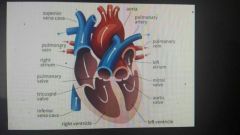![]()
![]()
![]()
Use LEFT and RIGHT arrow keys to navigate between flashcards;
Use UP and DOWN arrow keys to flip the card;
H to show hint;
A reads text to speech;
21 Cards in this Set
- Front
- Back
|
What is the respiratory system? |

-In order to do work the body needs energy -respiration is a chemical reaction which releases energy from the food we eat. - cellular respiration is the release of energy from food (glucose). It happens in every cell of our bodies - respiration happens in the mitochondria. |
|
|
How do our lungs work? |

-Air enters through the nostrils/mouth and travels down the trachea (windpipe) -the trachea divides into two bronchi - within each lung the bronchi divides into smaller tubes called bronchioles - at the end of the bronchioles are tiny air sacs called alveoli |
|
|
What are lungs? |
Organs used to take oxygen in and put waste carbon dioxide out. |
|
|
Trachea |
The tube that runs from the mouth down to the lungs |
|
|
Bronchi |
A a tube that runs from the trachea to the lung |
|
|
Bronchiole |
The branch of the bronchi the leads to the alveoli |
|
|
Alveoli |
Tiny airbags in lungs, thin walled spongy tissue where gas exchange takes place |
|
|
The human anatomy |

|
|
|
Capillaries |
Capillaries are sites of exchange materials between blood and tissues Capillary networks in alveoli and organ sites of gas exchange |
|
|
The heart |
-The heart is a hollow muscular organ -There are two sides and four chambers: upper Chambers are called atriums and lower Chambers are called ventricles - the blood flow through the heart one way - |
|
|
Flow of blood through the heart-LORD |
L- left side receives O- oxygenated blood and delivers it to the blood tissues R- right side receives D- deoxygenated blood and delivers it to the lungs |
|
|
Mass and weight |
-Mass is the amount of matter in an object and is measured in grams or kilograms -Weight is the force on the object caused by the pull of gravity and is measured in Newton using a spring balance - weight is a force due to Gravity |
|
|
Forces |
-A force is a push pull or a twist - a force cannot be seen but you can see the effects of a force on an object e.g. to change shape, to start moving, to speed up, to slow down |
|
|
Kinetic energy |
-Kinetic energy is the amount of energy a moving object has - as an object speeds up it gains kinetic energy and as it slows down it is losing kinetic energy - a moving object has the capacity to do work on anything at hits e.g. a car crashes |
|
|
Formula for kinetic energy |

|
|
|
Formula for Gravitational potential energy and what it is |

An object can store energy due to height above the Earth called gravitational potential energy E.g. a boulder on a mountain has gravitational potential energy. The boulder has the potential to do work (damage) If it falls. As the boulder Falls it's potential energy decreases while it's kinetic energy increases |
|
|
Formula for weight |

W = mg Weight = mass x gravity |
|
|
Formula for energy
|
E = MGH Energy = mass x gravity x height |
|
|
Energy |
-The higher something is the more energy it has - a very high object has lots of gravitational potential energy - the faster something is the more energy it has - a very fast object has lots of kinetic energy |
|
|
What path does oxygenated blood take through the Heart? |

|
|
|
Diagram of the heart |

|

